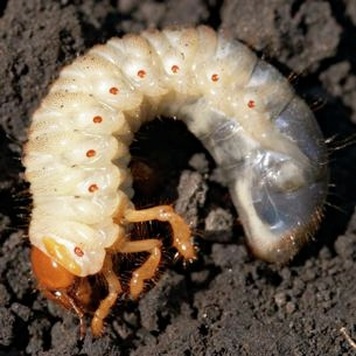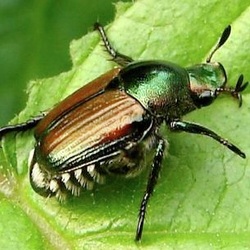Analyzing Lawn Grub Problems

White Lawn Grub
If you are wondering about lawn grubs and how to control them, read on.
Late summer to early fall are key times for lawn grubs to begin showing their damage to your lawn.
Although some lawns may be spared the damage, this insect can devastate your lawn in a short period of time.
How Do You Know If You Have Lawn Grubs?
These grubs, additionally known as white grubs feed on the turf root structure, causing wilting and browning in large, irregular-configured areas. Even though you may have brown spots in your turf, do not instinctively assume you have a grub problem as there can be numerous conditions circumstances that cause this in late summer.
You should always inspect the root zone in the affected areas for the "C-Shaped" white grubs.
Late summer to early fall are key times for lawn grubs to begin showing their damage to your lawn.
Although some lawns may be spared the damage, this insect can devastate your lawn in a short period of time.
How Do You Know If You Have Lawn Grubs?
These grubs, additionally known as white grubs feed on the turf root structure, causing wilting and browning in large, irregular-configured areas. Even though you may have brown spots in your turf, do not instinctively assume you have a grub problem as there can be numerous conditions circumstances that cause this in late summer.
You should always inspect the root zone in the affected areas for the "C-Shaped" white grubs.
Here Is How You Do It:
Cut the turf back in the affected area at the margins where the brown areas meet the healthy, unaffected turf areas. If you locate lawn grubs in these areas, take a count of the grubs. If you have more than 10 to 12 lawn grubs per square foot, it can lead to lawn browning.
There are other turf related problems that can cause turf wilting and browning as well. A typical mistaken condition is at shaded turf areas. The lawn in these areas is ordinarily shallow rooted and it is easy to lift. Shady turf areas are typically not affected by lawn grubs.
Also, in early spring, the turf can easily be lifted and can be mistaken for a lawn grub problem. It is easy to lift the sod of any grass areas that die out as the root structure rots away. So trying to diagnose grub damage from the previous season as the cause of a dead lawn area in spring is very difficult to do, even if limited roots are found in an area of dead grass.
If you find that you have skunks and raccoons digging up your turf overnight, you may have a lawn grub infestation as well. Although a mole problem can indicate that you have a lawn grub infestation, it is not an absolute conclusion.
There are other turf related problems that can cause turf wilting and browning as well. A typical mistaken condition is at shaded turf areas. The lawn in these areas is ordinarily shallow rooted and it is easy to lift. Shady turf areas are typically not affected by lawn grubs.
Also, in early spring, the turf can easily be lifted and can be mistaken for a lawn grub problem. It is easy to lift the sod of any grass areas that die out as the root structure rots away. So trying to diagnose grub damage from the previous season as the cause of a dead lawn area in spring is very difficult to do, even if limited roots are found in an area of dead grass.
If you find that you have skunks and raccoons digging up your turf overnight, you may have a lawn grub infestation as well. Although a mole problem can indicate that you have a lawn grub infestation, it is not an absolute conclusion.
Why is it that not all lawns in a particular neighborhood are not affected equally?

Japanese Beetle
The reason for this is the adult stage of the grub is the Japanese Beetle, which flies. So as you an see, if the beetles fly into your yard is is by random chance.
Also, be aware that the adult beetles prefer to lay their eggs in well-watered, full sun, turf areas. Normally these eggs are laid in the month of July.
So if you have been experiencing a dry spell, but have been watering you lawn and your neighbors have not, the beetle will likely select your lawn to reproduce.
Lawn Grubs - Can You Predict If You Will Have Them?
It is difficult, and many factors influence the chances of grubs appearing in your lawn. The first indication is if you see lots of adult beetles on the lawn in July.
Another indication is by spotting Masked Chafers, which are the adult of the annual white grub. They are commonly active around or shortly after sundown.
You will discover Japanese beetles active during the daytime hours and they typically feed of ornamental plants. Make sure you keep an eye on your turf from about mid-August through the month of September. Watch for browning and wilting turf areas, and be sure you examine the affected turf root zone for grubs.
Also, be aware that the adult beetles prefer to lay their eggs in well-watered, full sun, turf areas. Normally these eggs are laid in the month of July.
So if you have been experiencing a dry spell, but have been watering you lawn and your neighbors have not, the beetle will likely select your lawn to reproduce.
Lawn Grubs - Can You Predict If You Will Have Them?
It is difficult, and many factors influence the chances of grubs appearing in your lawn. The first indication is if you see lots of adult beetles on the lawn in July.
Another indication is by spotting Masked Chafers, which are the adult of the annual white grub. They are commonly active around or shortly after sundown.
You will discover Japanese beetles active during the daytime hours and they typically feed of ornamental plants. Make sure you keep an eye on your turf from about mid-August through the month of September. Watch for browning and wilting turf areas, and be sure you examine the affected turf root zone for grubs.
How Can You Prevent Lawn Grub Damage?
Here are a few things for you to consider. One extreme option is to stop your lawn irrigation during the month of July so it will go dormant. This will deter the beetles from laying their eggs in your turf. This of course has a downside of a brown lawn in the middle of summer.
Another option for you is to use a preemptive grub control substance. Use this approach if you or your neighbors have had past problems with lawn grubs.
How Can I Get Rid Of Lawn Grubs?
The best method for lawn grub infestations is to use an organic bacterial application. While poisons will certainly do the job, you are introducing unhealthy circumstances to your family, pets and especially to the local song bird population. If applied per directions, one of the best control measures for lawn grubs is Milky Spore.
How Can You Repair Your Damaged Lawn?
If you have had some significant grub damage due to lawn grub infestations, you will need to employ various restoration methods.
The first thing you ought to do is to rake away dead debris.
Next by watering damaged turf areas, you may some of the root zones recover. This is particularly effective as the weather cools down.
Finally reseeding will be required in areas that don't recover, or are totally bare or severely thin. The ideal target date for lawn restoration will vary by your USDA zone, but generally in the colder regions of the country, Labor Day is about the right time.
Click on the link for more information on Milky Spore.
Another option for you is to use a preemptive grub control substance. Use this approach if you or your neighbors have had past problems with lawn grubs.
How Can I Get Rid Of Lawn Grubs?
The best method for lawn grub infestations is to use an organic bacterial application. While poisons will certainly do the job, you are introducing unhealthy circumstances to your family, pets and especially to the local song bird population. If applied per directions, one of the best control measures for lawn grubs is Milky Spore.
How Can You Repair Your Damaged Lawn?
If you have had some significant grub damage due to lawn grub infestations, you will need to employ various restoration methods.
The first thing you ought to do is to rake away dead debris.
Next by watering damaged turf areas, you may some of the root zones recover. This is particularly effective as the weather cools down.
Finally reseeding will be required in areas that don't recover, or are totally bare or severely thin. The ideal target date for lawn restoration will vary by your USDA zone, but generally in the colder regions of the country, Labor Day is about the right time.
Click on the link for more information on Milky Spore.
